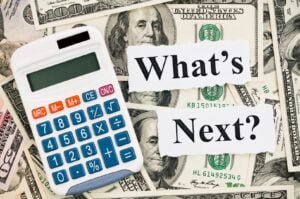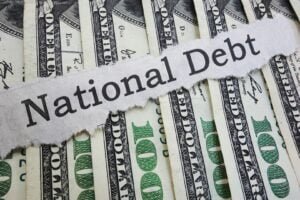This article is intended to “showcase” a new, novel approach on how, if Biden needs to—to go about negotiating with The Republicans employing a completely new strategy, in lieu of any OR a lesser tax increase, so that he can IMMEDIATELY BETTER INITIALLY fund the Entire Set of Startup Costs of the many Infrastructure Construction Projects he wants to engage in.
THE STRATEGY IS BONDS!!
HERE’S THE REASONING—SINCE THE REPUBLICANS WANT LESS TAXES FOR CORPORATIONS, THEN BIDEN SHOULD BE PUTTING AN OPTION TO PURCHASE U.S. TREASURY BONDS “ON THE TABLE” IN EXCHANGE FOR A LESSER OR NO TAX INCREASE AS SUCH CORPORATIONS COULD EASILY RESELL THESE BONDS ON THE OPEN SECONDARY BOND MARKET AT A SLIGHT DISCOUNT SUFFERING ONLY A MINIMAL LOSS COMPARED TO ANY TAX INCREASE THEY WOULD OTHERWISE INCUR!
FURTHERMORE, THIS STRATEGY WOULD SERVE A “DUAL PURPOSE” TO ALSO MOST DEFINITELY BENEFIT, SATURATE AND “PROP UP” A SERIOUSLY SAGGING BOND MARKET INDUSTRY DUE TO PRESENTLY EXTREMELY LOW BOND YIELD RATES AND LOOMING, IMPENDING POSSIBLE INFLATION!!
Now the article>>>
If President Biden can’t strike a deal with The Republicans, there’s always the upcoming vote in the Senate which fortunately for Biden falls under the less stringent “budget reconciliation” Senate parliamentary rule requiring only a 50,51 simple majority vote for passage (with VP Harris casting the tie-breaking vote in a 50/50 split.) This is assuming all 50 Democrats in the Senate will vote along Party lines. However, there are two possible holdouts–Senators Joe Manchin and Krysten Sinema.
Even assuming every Democrat votes in favor with Harris supplying the winning 51st vote, there’s one big problem with this Infrastructure Bill–the INITIAL FUNDING NEEDED for the enormous start-up costs of all the Infrastructure projects contemplated along with the INITIAL construction.
Here’s why–As it stands Biden wants to spread out (pro-rate) the entire cost of his Instructure Bill over a 14, 15 year period (there has been several varying reports going as low as 8 to 10 years.) Regardless, it would take several years of tax collection to cover these massive start-up construction costs for all the infrastructure needed to be done. This is NOW especially true since Biden’s plan to have the IRS commence an intensive audit program has been recently “taken off the table.”
To further complicate this–Biden ABSOLUTELY refuses to consider any more deficit spending by The Fed as The Fed since last year due to the pandemic has ALREADY expanded its Balance Sheet by several Trillion on top of Our ALREADY existing $22 Trillion National Debt we had before Covid even hit our shores!
So if Biden won’t let The Fed fund any of the start-up costs AND his corporate, capital gains tax increases and 2% wealth tax, etc. in his Infrastructure Bill is estimated to amount to an extra 3 Trillion (a figure put out by the news media) and is to be collected over a 14, 15 year period, this would equate to only a little over some 200+ Billion per year, then what??–When the initial start-up costs for his many Infrastructure projects WOULD BE IMMEDIATELY NEEDED TO PRE-PAY ALL THE GENERAL CONTRACTOR, CONSTRUCTION COMPANIES! What then??
The Republicans claim that there are $700 Billion in funds still yet unused in Biden’s Covid Relief Bill which technically could be repurposed to Biden’s Infrastructure Bill.
Even considering this, BONDS would still add to and make A BETTER (more comprehensive) ANSWER to the situation!! It would give Biden the massive upfront funding for the ALL start-up costs of the many, many projects in his Infrastructure Bill PLUS IT WOULD PROP UP A CURRENTLY SAGGING U.S. TREASURY BOND MARKET!!
For the massive upfront funding—Here’s how—For Biden to consider a lower than 28% corporate tax rate and also a lower than 43.4% (another big part of his Infrastructure Bill) which btw per reporting from the news media, has lots of room for compromise to possibly go down as low as 28-30%, The Republicans, corporations, businesses, institutional investors and the wealthy to get a more favorable tax rate–Bottom line–would have to buy a certain amount of bonds, the specifics of which, the amount, the length of maturity (obligation), etc. to be determined by study and further negotiations.
And As Stated, and this IS very, very important–If this were done–This would IMMEDIATELY give Biden the massive upfront funding for the start-up costs of all the projects his Infrastructure Bill would entail and, at the same time, give the Republicans, corporations, businesses, institutional investors and wealthy, as stated, a more favorable tax rate PLUS such corporations, businesses, institutional investors and wealthy would make some return (money/profit) on the bonds they purchased though, concededly, interest yield rates on bonds are presently pretty low.
AND HOW IT WOULD PROP UP A CURRENTLY SAGGING U.S. TREASURY BOND MARKET>>>
THE BONDHOLDER-CORPORATION WOULD HAVE THE CAPACITY TO SELL THESE BONDS AT ANY TIME. IN FACT, IT IS ANTICIPATED SUCH CORPORATIONS WOULD IMMEDIATELY SELL (AT RELATIVELY MINIMAL LOSS BTW) TO RE-ACQUIRE LIQUID CASH CREATING A SECONDARY BOND MARKET THE LIKES OF WHICH THAT COULD POSSIBLY EVEN MATCH THE EXTENT AND ACTIVITY OF OUR SECONDARY MORTGAGE MARKET!!
Here’s a possible solution–Corporations would pay a new 25% (and not 28%) corporate tax rate BUT ONLY IF they purchased enough bonds to cover all the estimated costs of the upfront funding needed for the start-up construction FOR the ALL the projects to be covered under Biden’s Infrastructure Bill.
To break it down with a tier-type bond purchase system, for example–Corporations would only pay the new 28% corporate tax IF they did not purchase a certain amount of bonds (to be assessed, say) by a certain percentage of their gross (or net) income (this to be determined by study.) If they purchased a pre-determined threshold amount, then they would pay a corporate tax rate of 27%. Now, if they bought an increased amount that would drop their tax rate down to 26% and if they purchased still more then they’d only pay 25%. AND if a corporation bought even more than that, they’d qualify for a new style bond series. Now, what’s that?
This “new style bond series” would be different and have the same characteristics as—get this—a 401(k), IRA where participating corporations, businesses, institutional investors and the wealthy would be able to carry forward a part of their profit (COMPLETELY TAX-DEFERRED) if they bought such bonds with these 401(k), IRA characteristics. These bonds, from hereon for conversational purposes, will be referred to as Profit-Carry-Forward Tax Deferred Bonds or for a more snazzier name—Biden’s Build Back America Better Bond Series!
ADDITIONALLY, THIS NEWLY PROPOSED BOND SERIES COULD WORK WELL CAPITALIZING BIDEN’S UP AND COMING 1.8 TRILLION AMERICAN FAMILIES PLAN.
Now, how would this new style Profit-Carry-Forward Tax Deferred Bond actually work? Corporations, businesses, wealthy and institutional investors would be allowed to purchase such bonds and have the amount of these bond purchases (pre-)deducted from their AGI (Adjusted Gross Income) in the same exact manner as when one buys into an IRA, 401(k) plan. And as with a 401(k), IRA when the bond matures or is redeemed, the tax otherwise owed that was initially deferred with this bond purchase would THEN become FULLY due and owing.
This way the government STILL GETS THE TAX on those bond dollars when they mature or are redeemed and, on top of that, in the meantime, the government gets the EXCLUSIVE use of those dollars while they’re being held as bonds by the bondholder! Also, this special bond series would, if anything, work to Biden’s advantage in negotiating a corporate and/or capital gains tax rate closer to his stated targeted objective(s) SINCE A PERCENTAGE OF THE BONDHOLDER’S PROFIT COULD NOW BE TAX DEFERRED, PROVIDED THEY BUY THESE SPECIAL SERIES BONDS!!
The SPECIFIC advantage to corporations, businesses, wealthy and institutional investors availing themselves of these special series bonds is that the bonds could be (strategically) redeemed and applied in any subsequent year where the corporation, business, wealthy or institutional, individual investor suffered a loss or had minimal/low income thus resulting in ONLY having to pay a lower overall combined tax or (2) redeeming and applying the principal from the bond in a year where it would be used for a business start-up, expansion, equipment purchases, refurbishments, etc. or for an unforeseen (business) emergency. This way such redeemed bond(s), if used in such a way, could be treated as a deductible business expense in the year of redemption and applied against the company’s AGI prior to declaring what taxable income would be owed.
Also, a third option would be where the bondholder could “convert” these tax deferred bonds into interest yielding investment bonds collecting a yearly yield with the DEFERRED tax owed on these bonds prorated and matched against the yield over the length of the bond if interest rates were to climb to such a level making such a move to “convert” become profitable.
To put everything in perspective, as per this discussion of The Use of Bonds to initially fund the start-up costs of Biden’s Infrastructure Plan & Bill using conventional U.S. Treasury Bonds and these new style Profit-Carry-Forward Tax Deferred Bonds, what this article is suggesting is just a suggestion only–Any combination of the above that would work better would be the way to go. This article is only a suggestion to look at the Use of Bonds in some general form. The specific combination or Plan would be left up to the experts.
Now for some overall conclusions—It is conceded that as these bonds mature or are redeemed the amount of these bonds would have to made good by the government. However, it is felt that this program would become so popular and, as a result—there would always be a steady influx of new incoming dollars each and every year from different and some repeat (customer) corporations, businesses, wealthy and institutional investors availing themselves of these new special series bonds with this 401(k), IRA tax deferment characteristic such that the money from these new incoming bonds would be able to retire older bonds maturing or being redeemed. And if there were a shortage, the government’s general tax revenue base being collected every year would be used. And if needed, there is also the option of U.S. Treasury Dept. bond auctions OR additional, periodic deficit spending by The Fed.
Nevertheless, notwithstanding, it is predicted there would be a sufficient influx of new cash and bonds coming in every year to handle any maturing or redeemed bonds. In fact, it is felt there would be such a huge volume of these and other U.S. Treasury bonds normally being sold by The Treasury Dept. that this would PROP UP A PRESENTLY SAGGING BOND MARKET ALSO CREATING A SECONDARY BOND MARKET THE LIKES OF WHICH WE’VE NEVER SEEN BEFORE SIMILAR IN OPERATION AND NATURE TO OUR SECONDARY MORTGAGE MARKET AND ALLOW THE FED BETTER CONTROL OVER INTEREST RATES, in that, because of this new predicted level of volume of bonds, there would be LESS reason to conduct bond auctions (OR MORE DEFICIT SPENDING) if it is felt there would be an upcoming shortage of general government TAX revenue needed for the proper functioning of its operations. And with bond auctions, if that be the case, this is where interest rates could possibly have to be raised to attract enough buyers and additional cash. So, LESS bond auctions, LESS chance of interest rates going up!
Also, in the same breath and as a further (logical) extension of the above, if this new series of tax-deferred bonds were made available causing such an influx of new bond purchasers and purchases, this would act as added assurance to prospective bondholders, that the principals of the bonds (with the interest rate yields being purchased) would have less chance in the future to go down in value because of interest rates later climbing making the principals of those bonds now being considered to be held less likely to go down in value.
One must keep in mind, though, The Fed IS, at the appropriate time, seeking to raise interest rates up to 2% (or slightly above) to match the consumer price index (CPI). However, if excessive inflation begins to occur, and this COULD POSSIBLY be the case at some point down-the-road, due, in part, to recent substantial deficit spending this past year by The Fed to keep The Economy afloat, the one tool The Fed has IS to RAISE interest rates to “cool down” The Economy.
ALSO, IN REFERENCE TO THIS NEW SECONDARY BOND MARKET WHERE MANY CORPORATIONS WOULD BE SELLING THEIR BONDS TO OTHER BONDHOLDERS, INSTITUTIONAL INVESTORS AND PENSION-RETIREMENT FUNDS TO RECAPTURE CASH CAPITAL TO UTILIZE FOR CORPORATE BUSINESS PURPOSES, THIS WOULD ALSO ACT TO FURTHER MAINTAIN SUFFICIENT VOLUME IN THE BOND MARKET WHICH IN TURN WOULD PROVIDE BETTER INTEREST RATE STABILIZATION BY NOT HAVING TO REVERT TO BOND AUCTIONS, ADDED DEFICIT SPENDING, ETC!!
Please note, having a larger pool bond market, as per our prior discussion and having a mechanism by which such a larger pool of bonds can be better, more easily maintained, again, as per our prior discussion, by having the aforementioned special bond series with 401(k), IRA type tax deferment incentives available (since bond yields by themselves because of presently low interest rates would not be enough incentive-wise) would also, at the same time, functionally serve as a self-regulating “shunt” mechanism drawing capital away from the private sector when/if/where inflation begins (or is about) to occur if such occasion should arise by offering a SAFER, better (tax deferment) investment incentive to corporations, businesses and investors than that which would be existing in the market and by way of general business speculation and most certainly would be a welcome added safeguard to The Fed to combat Inflation by making available to such investors, corporations, businesses this safe, secure, guaranteed tax avoidance investment alternative.
As stated above, this new series of tax deferment bonds and accelerated bond purchases in toto would ALSO, and at the same time, allow for a better, more efficient use of money supply when considering the total spectrum of our economic and societal landscape by redirecting CAPITAL (money supply) away from the private sector (business community) to be used in the public sector when/where (especially) needed (A FRESH NEW AREA OF INVESTMENT) to benefit the nation at large (e.g., infrastructure) as opposed to now, just to give an example, the stock market, in part, is being bid up in anticipation of business returning to normalcy and for future profits but there is also an inflationary aspect to this market bid-up because of an overall contraction and lack of an up-to-now business opportunity elsewhere in The Economy (less places for entrepreneurs and investors to “park” their money.) Although this is rapidly changing, as we speak, as The Economy is now beginning to recover from the pandemic…
BUT rebuilding and expanding Our Infrastructure (THIS FRESH NEW AREA OF INVESTMENT) would be the better choice and use of Our Money (Supply) as it serves the DUAL purpose of modernizing a much outdated set of (communication and connectivity) systems which are absolutely essential to the proper, efficient operation of An Economy that btw desperately needs a “re-fit” PLUS…
The Use of Funds in this area (again, A FRESH NEW AREA OF INVESTMENT) versus continued investment in the stock market would put a vastly LARGER number of people and businesses back to work, furthermore and more dramatically Increasing Our Tax Revenue Base as well!
LASTLY, as per the above discussion of The Use of Bonds to initially fund the start-up costs of Biden’s Infrastructure Bill and Plan using conventional U.S. Treasury Bonds and the new style Profit-Carry-Forward Tax Deferred Bonds, what this article suggested was just a suggestion only–Any combination of the above that would work better would be the way to go. This article is only a suggestion to look at the Use of Bonds. Again–The specific combination or Plan would be left up to the experts.
Published by OnTheEconomy.com




